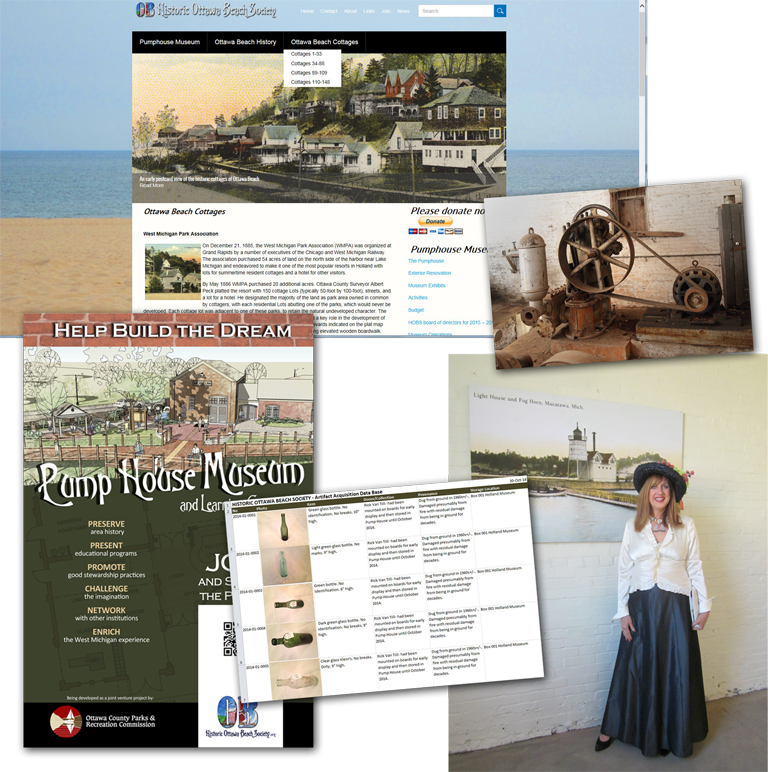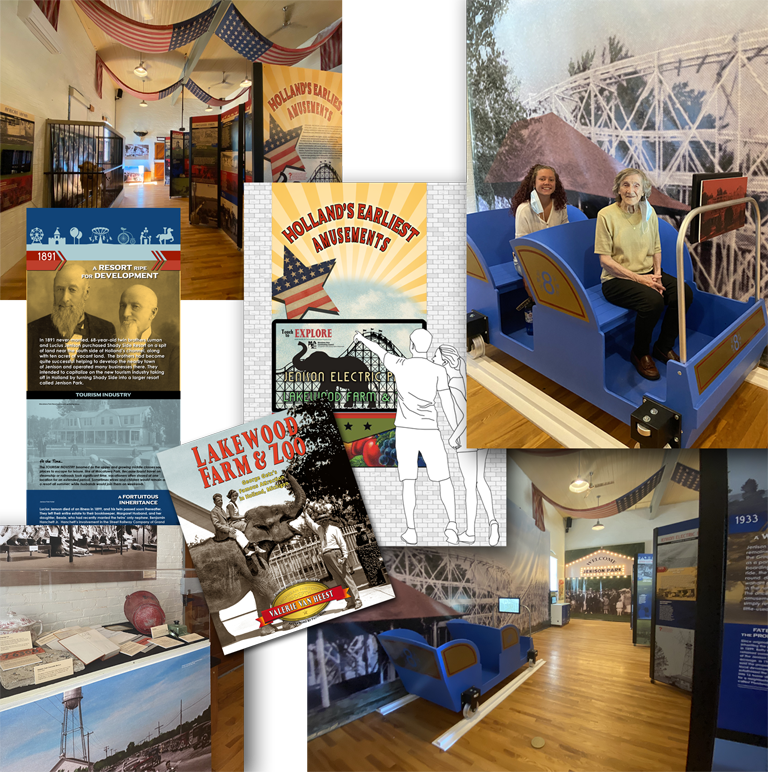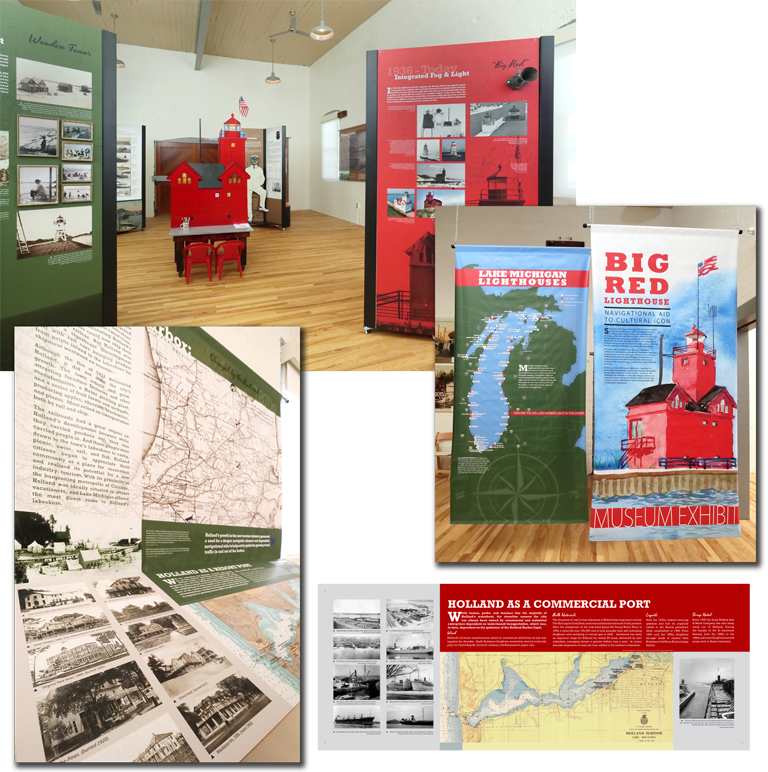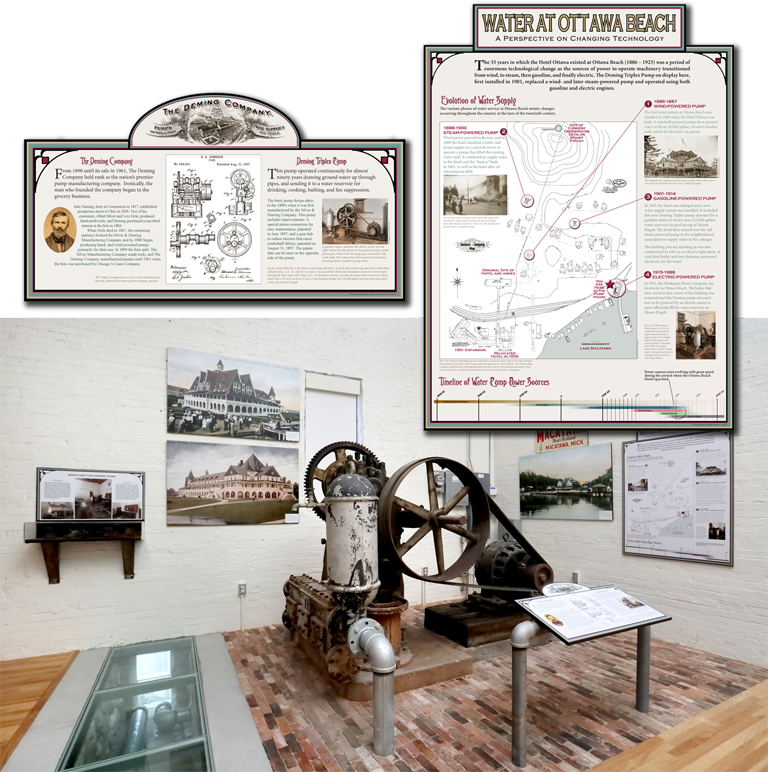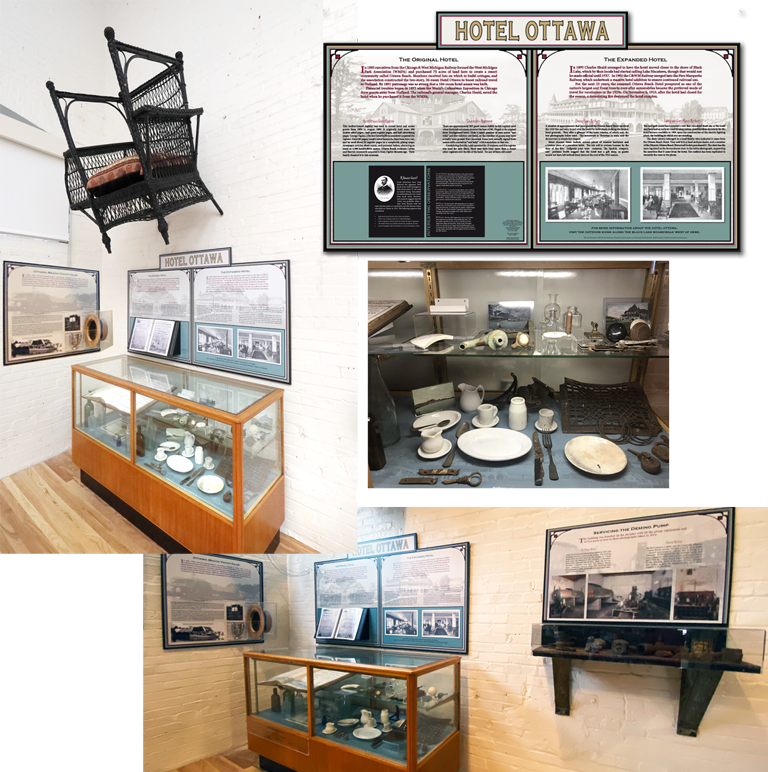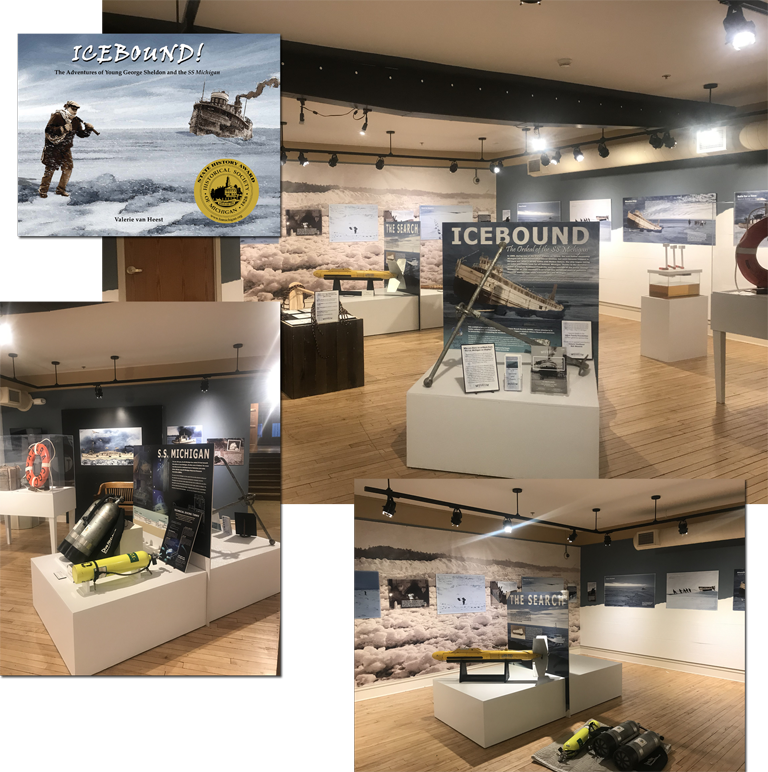Pump House Museum and Learning Center
Museum Development and Promotion
Historic Ottawa Beach Society – Holland, Michigan
2008- Ongoing
Since the Society’s founding in 2010, LVH has provided architectural, interior design, graphic design, marketing, curatorial, and exhibit design services to the Historic Ottawa Beach Society and its partner the Ottawa County Parks and Recreation Department to convert a century old water pumping building to a museum. Services have included the redesign the society’s website, promotional literature and advertisements, logo development, exterior signage, toilet room design, accessioning over 100 artifacts into the society’s collection, and developing permanent exhibits, including the first, “Vintage Views” a large format postcard exhibit. The museum received the 2018 Preservation Award from the Historical Society of Michigan based on an application written by LvH partner Valerie van Heest, who also delivered several programs in vintage costume and character. Currently LvH is developing funding materials for a building addition.
Holland’s Earliest Amusements
Pump House Museum, Historic Ottawa Beach Society – Holland, Michigan
2020 – 2022
This 750-square foot exhibit is running from 2020 through 2022. It includes an interactive roller coaster ride, lion mount, and touch screen virtual exploration of Jenison Electric Park and Lakewood Farm. As a part of the exhibit, Valerie van Heest authored the book Lakewood Farm as a companion to the exhibit and wrote the National Register Nomination for the Property.
EXHIBIT SYNOPSIS: Holland, Michigan, a tourist Mecca during the first third of the 20th century, saw as many as a million visitors each year traveling here to visit Lakewood Farm and Zoo on the north side of Lake Macatawa and Jenison Electric Park on the south side. Immerse yourself in the sights, sounds, and thrills of these two famous amusements framed in the context of the technological revolution of the late 19th century and the Progressive Era in the early 20th century. During that time Americans responded to the problems created by rapid industrialization with social, political, and economic movements designed to improve the lives of the expanding working and middle classes. Explore how George Getz of Lakewood Farm and Benjamin Hanchett of Jenison Electric Park created attractions where people could escape growing urban metropolises, and how these attractions helped shape Holland into the tourist destination it is today.
Big Red: From Navigational Aid to icon
Pump House Museum, Historic Ottawa Beach Society – Holland, Michigan
2018-2019
This 750-square foot exhibit ran from 2017 to 2019, and for the 2020 exhibit has been converted to a permanent touch screen, digital exhibit occupying only 25 square feet. The original exhibit will be housed permanently at the Big Red Lighthouse.
EXHIBIT SYNOPSIS: Since they first appeared on the Mediterranean coast thousands of years ago, lighthouses have served as navigational aids, a vital aspect of seaborne commerce. The Holland Harbor Light, erected in 1870 and transformed over decades to assume its present form, played a critical role guiding mariners along Michigan’s treacherous coast and into Holland’s safe harbor, allowing the development of Holland as a busy commercial port.
A century after the light first operated, technical advances in navigation rendered the lighthouse obsolete, jeopardizing its future existence. However, the citizens of Holland recognized that “Big Red” had become an endearing and enduring historical and cultural icon, leading to the formation of a commission to preserve the structure.
Unlike any other Michigan lighthouse, “Big Red” is surrounded by privately owned land, which limits public access. This exhibit provides “virtual” access to the lighthouse by sharing its long and complex history, its transition from a navigation aid to a cultural icon, and its status today as Michigan’s most photographed and recognizable lighthouse.
Water at Ottawa Beach
Pump House Museum, Historic Ottawa Beach Society – Holland, Michigan
Permanent Display
LVH meticulously researched the various utilities that services homes and businesses at Ottawa Beach to create this small, but significant, exhibit “Water at Ottawa Beach,” created for the museum and building owners, Ottawa County, interprets the evolution of public utilities featuring the century-old Deming water pump, which gave name to the museum. Valerie van Heest also developed a public lecture regarding the topic to deliver to area groups.
Hotel Ottawa
Pump House Museum, Historic Ottawa Beach Society – Holland, Michigan
Permanent Display
Using artifacts discovered in the ground at Ottawa Beach, a piece of hotel furniture, a loving cup, and the only hotel guest register discovered, LVH designed this small exhibit to interpret the former hotel that drew millions to the Holland area in the late 19th and early 20th century.
Icebound: The Ordeal of the SS Michigan
Pumphouse Museum, Historic Ottawa Beach Society – Holland, Michigan
2016-2017 Temporary/Traveling Exhibit
This exhibit is based on the award-winning children’s book “Icebound” by exhibit designer and author Valerie van Heest of LvH. It debuted as a wall-mounted panel exhibit before the Pump House could officially be opened as a museum. The exhibit was available to tour free of charge during open house exhibits in the summer season. When the museum officially opened, HOBS tasked LVH with developing a new exhibit and loaned the Icebound exhibit to the Tri Cities Historical Museum in Grand Haven, which added artifacts and wall effects to expand the exhibit. It was on display there for an additional year.
EXHIBIT SYNOPSIS: In 1885, during one of the brutal winters on record, the iron-hulled steamship Michigan left Grand Haven on a rescue mission, but soon became trapped in the pack ice. Over the next several weeks, the youngest crewman, George Sheldon, courageously trekked back and forth across the ice to deliver food and supplies to keep his mates alive as they waited for the ice to break up. However, after 38-days the ship began taking on water. Captain Redmond Prindiville gave the order to abandon it just before the steamer sank, and George Sheldon led them all safely across the frozen lake to Holland some 15 miles distant.
For over 130 years, the SS Michigan lay hidden 275 feet beneath the surface of Lake Michigan, 18 miles west of Holland. The wreck was discovered by a dedicated team of historians and scuba divers with the nonprofit Michigan Shipwreck Research Association (MSRA). The wooden cabins have collapsed, but the iron hull is intact and has settled upright into the silty lake bottom. Underwater footage shows its condition today.

